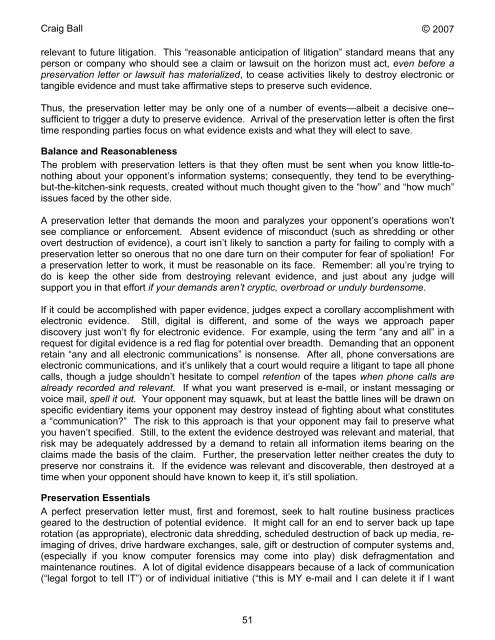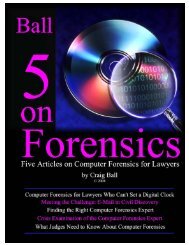Six Articles on Electronic - Craig Ball
Six Articles on Electronic - Craig Ball
Six Articles on Electronic - Craig Ball
You also want an ePaper? Increase the reach of your titles
YUMPU automatically turns print PDFs into web optimized ePapers that Google loves.
<strong>Craig</strong> <strong>Ball</strong> © 2007<br />
relevant to future litigati<strong>on</strong>. This “reas<strong>on</strong>able anticipati<strong>on</strong> of litigati<strong>on</strong>” standard means that any<br />
pers<strong>on</strong> or company who should see a claim or lawsuit <strong>on</strong> the horiz<strong>on</strong> must act, even before a<br />
preservati<strong>on</strong> letter or lawsuit has materialized, to cease activities likely to destroy electr<strong>on</strong>ic or<br />
tangible evidence and must take affirmative steps to preserve such evidence.<br />
Thus, the preservati<strong>on</strong> letter may be <strong>on</strong>ly <strong>on</strong>e of a number of events—albeit a decisive <strong>on</strong>e--<br />
sufficient to trigger a duty to preserve evidence. Arrival of the preservati<strong>on</strong> letter is often the first<br />
time resp<strong>on</strong>ding parties focus <strong>on</strong> what evidence exists and what they will elect to save.<br />
Balance and Reas<strong>on</strong>ableness<br />
The problem with preservati<strong>on</strong> letters is that they often must be sent when you know little-t<strong>on</strong>othing<br />
about your opp<strong>on</strong>ent’s informati<strong>on</strong> systems; c<strong>on</strong>sequently, they tend to be everythingbut-the-kitchen-sink<br />
requests, created without much thought given to the “how” and “how much”<br />
issues faced by the other side.<br />
A preservati<strong>on</strong> letter that demands the mo<strong>on</strong> and paralyzes your opp<strong>on</strong>ent’s operati<strong>on</strong>s w<strong>on</strong>’t<br />
see compliance or enforcement. Absent evidence of misc<strong>on</strong>duct (such as shredding or other<br />
overt destructi<strong>on</strong> of evidence), a court isn’t likely to sancti<strong>on</strong> a party for failing to comply with a<br />
preservati<strong>on</strong> letter so <strong>on</strong>erous that no <strong>on</strong>e dare turn <strong>on</strong> their computer for fear of spoliati<strong>on</strong>! For<br />
a preservati<strong>on</strong> letter to work, it must be reas<strong>on</strong>able <strong>on</strong> its face. Remember: all you’re trying to<br />
do is keep the other side from destroying relevant evidence, and just about any judge will<br />
support you in that effort if your demands aren’t cryptic, overbroad or unduly burdensome.<br />
If it could be accomplished with paper evidence, judges expect a corollary accomplishment with<br />
electr<strong>on</strong>ic evidence. Still, digital is different, and some of the ways we approach paper<br />
discovery just w<strong>on</strong>’t fly for electr<strong>on</strong>ic evidence. For example, using the term “any and all” in a<br />
request for digital evidence is a red flag for potential over breadth. Demanding that an opp<strong>on</strong>ent<br />
retain “any and all electr<strong>on</strong>ic communicati<strong>on</strong>s” is n<strong>on</strong>sense. After all, ph<strong>on</strong>e c<strong>on</strong>versati<strong>on</strong>s are<br />
electr<strong>on</strong>ic communicati<strong>on</strong>s, and it’s unlikely that a court would require a litigant to tape all ph<strong>on</strong>e<br />
calls, though a judge shouldn’t hesitate to compel retenti<strong>on</strong> of the tapes when ph<strong>on</strong>e calls are<br />
already recorded and relevant. If what you want preserved is e-mail, or instant messaging or<br />
voice mail, spell it out. Your opp<strong>on</strong>ent may squawk, but at least the battle lines will be drawn <strong>on</strong><br />
specific evidentiary items your opp<strong>on</strong>ent may destroy instead of fighting about what c<strong>on</strong>stitutes<br />
a “communicati<strong>on</strong>?” The risk to this approach is that your opp<strong>on</strong>ent may fail to preserve what<br />
you haven’t specified. Still, to the extent the evidence destroyed was relevant and material, that<br />
risk may be adequately addressed by a demand to retain all informati<strong>on</strong> items bearing <strong>on</strong> the<br />
claims made the basis of the claim. Further, the preservati<strong>on</strong> letter neither creates the duty to<br />
preserve nor c<strong>on</strong>strains it. If the evidence was relevant and discoverable, then destroyed at a<br />
time when your opp<strong>on</strong>ent should have known to keep it, it’s still spoliati<strong>on</strong>.<br />
Preservati<strong>on</strong> Essentials<br />
A perfect preservati<strong>on</strong> letter must, first and foremost, seek to halt routine business practices<br />
geared to the destructi<strong>on</strong> of potential evidence. It might call for an end to server back up tape<br />
rotati<strong>on</strong> (as appropriate), electr<strong>on</strong>ic data shredding, scheduled destructi<strong>on</strong> of back up media, reimaging<br />
of drives, drive hardware exchanges, sale, gift or destructi<strong>on</strong> of computer systems and,<br />
(especially if you know computer forensics may come into play) disk defragmentati<strong>on</strong> and<br />
maintenance routines. A lot of digital evidence disappears because of a lack of communicati<strong>on</strong><br />
(“legal forgot to tell IT”) or of individual initiative (“this is MY e-mail and I can delete it if I want<br />
51













